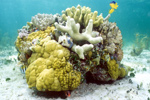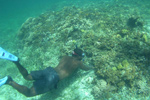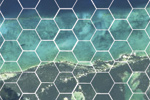
Acropora palmata reef. Habitat classification. Reefs with the coral Acropora palmata, also called Elkhorn Coral, typically have high vertical relief. This habitat is found at the crest of the reef. Although A. palmata is generally the most common coral in this habitat, the bottom community also includes other stony corals, gorgonians, and algae. This habitat is found between approximately 1 and 5 meters deep.
Average catch weight (kg.). Simulation fish parameter. Average weight of fish caught (kg; 0.1 -1000.0).
Base image of display. Simulation general parameter. Image that is used for the background of the simulation.
Batophora dominated. Habitat classification. This habitat contains abundant patches of the club-like algae Batophora and is typically on a hard bottom with a small amount of sediment. This kind of algae is also often seen growing on conch shells. Other algae and some patches of seagrass are often present in this habitat, which is founding low energy lagoonal environments.
Boat cost ($/day). Simulation boat parameter. Cost per day to operate a boat, excluding travel (0 - 1000).
Carrying capacity. Simulation fish parameter. Maximum population per hexagon, in optimal conditions (0 - 100,000).
Dead coral and Microdictyon. Habitat classification. In some areas, the majority of corals have died, possibly during bleaching events. These habitats are in shallow waters and appear to have been similar to Montastraea reef communities. They still have the rough structure of a coral rich area. The mesh-like algae Microdictyon is seasonally common and covers the substrate, presumably flourishing after the loss of live coral colonies. This habitat is found in a limited number of areas just landward of the reef crest.
Dense seagrass. Habitat classification. This habitat is dominated by the seagrass Thalassia, also called Turtle Grass, but may contain the tube-like seagrass Syringodium. Dense Seagrass habitats have high biomass (tall plants, high density) and a low amount of visible sand and silt. This habitat is found in lagoonal environments where sediment is deep enough for the seagrasses to take root.
Dispersal rate. Simulation fish parameter. Percent of fish that move to another cell per day (0.0 - 75.0).
Fishing efficiency. Simulation boat parameter. Fraction of a cell's fish that a boat can catch per day (0.0 - 1.0).
Initial population. Simulation fish parameter. Initial total fish population (0 - 10,000,000). For purposes of the simulation, some of the default values may be more representative of well-established and protected areas than initially unprotected systems. These can be changed at will.
Intrinsic growth rate. Simulation fish parameter. Population growth rate per year, in optimal conditions (0.0 - 2.0).
Lifespan. Simulation fish parameter. Typical lifespan (days; 0 - 100,000).
Mangrove. Habitat classification. Mangrove trees grow in shallow, brackish waters along coasts and up creeks of some islands. Their roots provide nursery habitat for many important fish species. Mangroves in and around estuaries also trap sediments that might otherwise flow onto reefs and smother corals to death.
Maximum boats per port. Simulation boat parameter. Maximum number of boats per port (0 - 1000).
Maximum days simulated. Simulation general parameter. Stop simulation after this number of days (1 - 1,000,000).
Maximum harvest (kg). Simulation boat parameter. Maximum catch per day (kg; 0 - 10,000).
Medium density seagrass. Habitat classification. This habitat is dominated by the seagrass Thalassia, also called Turtle Grass, but may contain the tube-like seagrass Syringodium and the thin-bladed seagrass Halodule. Occasionally one also finds small coral colonies within the seagrass. Medium Density Seagrass habitats have medium biomass (medium plant height, medium density) and a medium amount of substratum is visible, when compared to Dense and Sparse Seagrass. This habitat is found in lagoonal environments.
Minimum population size. Simulation general parameter. Stop simulation if fish population drops below this number (0 - 10,000,000).
Montastraea reef. Habitat classification. The coral species Montastraea annularis, also called Boulder Star Coral, is the dominant coral species in this habitat. This benthic community is diverse, including corals, sponges, gorgonians, and algae. Montastraea Reef also supports a diverse and abundant fish community. This habitat is found in some reef environments between approximately 5 and 15 meters deep.
Patch reef. Habitat classification. Patch reefs are reef formations often found in lagoons and surrounded by seagrass beds. They commonly have a small �halo' around them of relatively clear sand cleaned by grazing fish and invertebrates. They support much more diverse invertebrate and fish communities than surrounding habitats.
Porites reef. Habitat classification. At some sites, there are unusual areas of extensive growth of the Finger Coral Porites porites. These areas typically support an abundant number of juvenile fish, particularly grunts, parrotfish, wrasse, and damselfish. These reefs are found in shallow water less than 2 meters deep.
Price ($/kg). Simulation boat parameter. Price per kilogram received by fishermen (0.0 - 100.0).
Sand. Habitat classification. This habitat includes both clean sand and sand with a sparse algal community. It is found in lagoonal areas and near reefs.
Sargassum on hardbottom. Habitat classification. This habitat contains numerous Sargassum plants, typically on a hardbottom with a limited covering of sediment. In some areas, the Sargassum plants reach greater than 1 meter tall. Other algae often occur between the Sargassum plants. This habitat occurs in medium energy lagoonal environments.
Silt / mud. Habitat classification. Silt, which is finer than sand, is often present near shore areas and creeks. Seagrass and algae are often present in this shallow water habitat.
Simulation speed. Simulation general parameter. Number of days simulated per second of animation (1 - 100).
Sparse gorgonians and algae. Habitat classification. Gorgonians include sea fans, sea feather plumes, sea whips, and sea rods. This habitat is composed of sparse gorgonians on a hardbottom with some algae. In some areas, this benthic community is found in shallow reef environments and on hardbottom in the lagoon area.
Sparse seagrass. Habitat classification. This habitat is dominated by the seagrass Thalassia, also called Turtle Grass, but may contain the tube-like seagrass Syringodium and the thin-bladed seagrass Halodule. Occasionally one also finds small coral colonies within the seagrass. Sparse Seagrass habitats have relatively low biomass (short plants, low density) and a high amount of substratum is visible. This habitat is found in lagoonal environments where sediment is deep enough for the seagrasses to take root.
Speed (km/hr). Simulation boat parameter. Speed of travel to fishing grounds (km/hr; 0 - 100).
Travel cost ($/day). Cost per day to operate a boat to and from fishing grounds (0 - 1000).
Uncolonized pavement and sparse gorgonians. Habitat classification. Uncolonized Pavement is found in one of the high energy 'cuts' through the Acropora reef crest. This habitat is similar to the Sparse Gorgonians and Algae habitat but it has very few gorgonians and algae.






